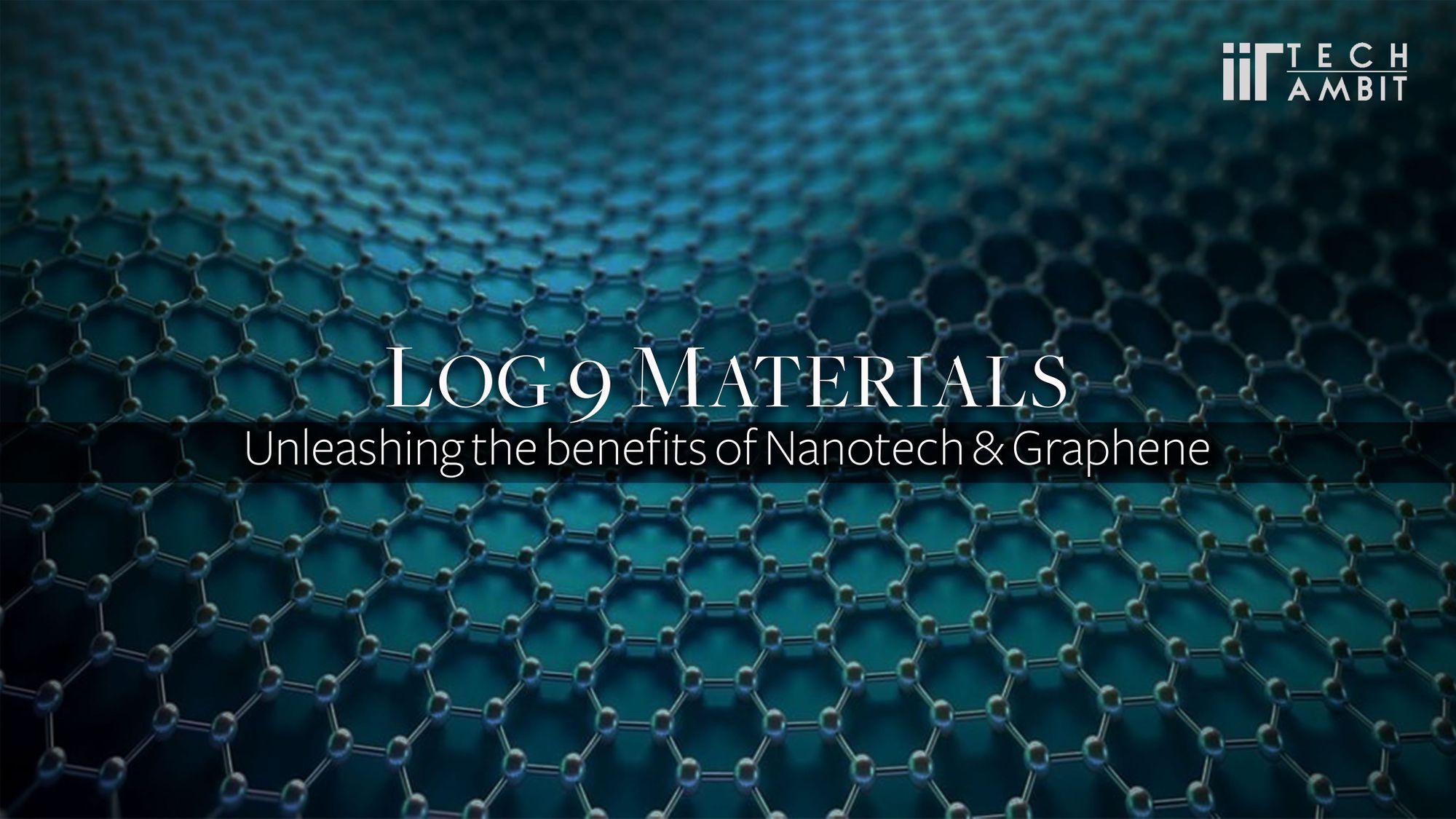Written by Akshara Singh, Arpit Maheshwari, Malika Rashu
From humble beginnings to a promising future
Log 9 Materials was incubated by the Technology Innovation & Development of Entrepreneurship Support (TIDES) Business Incubator at Indian Institute of Technology, Roorkee in December 2015.
Founded by Akshay Singhal and Kartik Hajela they has acquired 16 patents in graphene synthesis and graphene products.
They are a determined team of scientists and engineers working on commercializing Graphene. The development of new frontiers in Graphene synthesis of various forms, reduction and functionalization and designing innovative applications paved the way for the foundation of the company.
Since inception in 2015, Log 9 Materials has attempted to solve a myriad of practical and real-life challenges with the novel use of graphene nanotechnology. While in the initial years the startup experimented and developed product prototypes in a variety of domains, it has narrowed down to only two sectors in the recent past – filtration and energy.
The IIT Roorkee spin-off has raised seed funding in March 2017, followed by pre-Series A funding of around Rs 3 crore in 2018. Recently it has raised a fresh round of Series-A funding of Rs 24.22 crore from Sequoia India's scale up program Surge and Exfinity Venture Partners. This is the third round of funding raised. Log 9 Materials is said to have a revenue of $2M. The company has said that the fresh funds would be utilized for product advancement of the aluminum fuel cells they are developing.
Log 9 materials was awarded "the most innovative technology of 2018". Akshay Singhal and Kartik Halega, the cofounders of log9 materials were listed in the Forbes 30 under 30 list - Asia: Industry, Manufacturing and Energy - in 2019.

Clean fuels: Caring for the Earth
Batteries and combustion engines each have distinctive benefits and limitations. Batteries have simple construction and operate silently; however, their energy density (i.e., the energy per unit volume) is poor, and lithium-ion batteries are potential fire hazards. The energy densities of combustion engines are higher than those of batteries, but combustion engines are relatively loud and emit toxic gases.
The energy system that employs an aluminum-based fuel is potentially safer, more reliable, and easier to refuel than alternatives. Additionally, an aluminum-fueled power system is simpler to start up and shut down than gasoline engines, and the system operates in extreme environments such as beneath the sea.
Another benefit of this technology is that the aluminium plates are exhaustive in nature and at the end of their useful life, they turn into an oxidized powder that can be sweltered into aluminium plates again. Hence, that actually makes the spent fuel recyclable.
The idea is to not only use these batteries to power cars but also to replace diesel generators that are used to power cellphone towers, ATM kiosks, and often meet household energy demands in India. Looking at the bigger picture, these batteries are the key to a brighter future.
For the auto sector, Log 9's pitch is simple. Electric vehicles that run on Li-Ion cells need specialized charging infrastructure sorely lacking in India which has only recently achieved 100% electrification. The current breed of EVs can’t cover long distances without being charged frequently. They promise a range of about 100 km to 200 km per charge with exceptions like the expensive Tesla cars that deliver over 500 km a charge.
There’s also a strategic advantage switching to metal-air batteries. India does not produce lithium and cobalt, the raw materials that go into making Li-ion batteries.
At a macroeconomic level, the benefits of using materials that can be broadly sourced locally to create energy solutions will directly impact GDP, fiscal deficit, and energy security and, thereby, national security.
The World of Aluminium-based Fuel Cells
Aluminium fuel cells primarily use three components – aluminium, water, and carbon in the form of graphene. In simple words, there’s water between layers of graphene, and when aluminium comes in contact with water, it corrodes – releasing energy.

These systems use aluminium as an anode, oxygen as the cathode, and water as an electrolyte. A porous membrane made of graphene- thin, light, strong, and an excellent conductor of heat and electricity- lets the air pass into the electrolyte chamber where a chemical reaction between aluminium, water and air (oxygen) takes place to release energy.
The basic chemistry of aluminum as a fuel relies on a reaction with water to generate hydrogen and heat according to the following:
2Al + 6H2 → 2Al(OH)3 + 3H2O + Q (Heat)
This reaction releases approximately 84 MJ/L of energy (almost evenly split between heat energy and potential energy in the form of hydrogen), which is more than twice the volumetric energy density of diesel fuel, and more than 3.5 times that of lithium.
The technology being developed by Log 9 Materials plays into the larger trend of decentralisation of energy across the world.
Such micro power plants will likely cover energy sources such as solar, wind, geothermal and, now, metal-air energy.
Decentralised energy creation should lead to an energy internet that could create an entirely new class of opportunities for economic growth and innovation.
Wide array of Applications
Log 9 Materials specializes in nanotechnology-based innovations mainly based upon graphene- an allotrope of carbon. It is this area of their core expertise that has seen some fascinating innovations through various products. The major reason why commercialization of graphene has lagged is the cost intensive processes that make it commercially unviable. This is the area where their research and innovation has made a profound impact and reduced the expenses involved. Thus, they manufacture graphene on a large scale and incorporate it in their product to realize its value.
Conventional electric vehicles require electricity for charging which again comes from thermal power plants based on fossil fuels. Also, the non-conventional sources of energy like wind and hydel require batteries to store power which ultimately end up in landfills. These are not end-to-end sustainable sources.
The scenario is quite different for aluminium fuel cells. They have an aluminium cassette in the middle and graphene membranes on both sides. The graphene membranes keep carbon dioxide out, while letting oxygen in. When energy is required water flows in and oxidation of aluminium occurs producing aluminium hydroxide as a by-product and evolution of energy occurs. The by-product can be re-smelted back to aluminium. Such a fuel cell can provide energy for a car to run 1000 km without any need for recharging.
Log 9 Materials has also offered solutions in the oil spill clean-up domain in the form of LOS (Log9 Oil Sorbent) which is a graphene based oil sorbent pad. Conventional synthetic pads based on polypropylene offer absorbance upto 20:1. An absorbance of ‘x’ implies ‘x’ gram of oil can be absorbed by 1 gram of pad. This absorbance, on the other hand, has an exceptionally high value ranging upto 86:1 for graphene-based pads. An important aspect of such pads is their recovery and surprisingly these pads can be reused 7-8 times depending on conditions.

The latest innovation of Log 9 Materials is the “CoronaOven'' which has been certified by the ICMR empanelled lab CSIR-CSIO. It uses chemical-free multi focal UV light exposure covering the item from multiple sides inside the chamber including the bottom. A 253.7nm wavelength of UVC is used here which has various germicidal applications.

So how is it different from the UV sterilization boxes already in use at hospitals and saloons? The answer lies in the fact that most UV boxes in market, in saloons and in hospitals are designed for broad spectrum UV light and not specifically for delivering 254 nm UV light. Moreover, UV light placement in such boxes does not ensure 360- degree irradiation. This leads to generation of shadow areas on objects placed inside these boxes which leaves patches of unexposed surfaces making such UV boxes unsuitable for decontaminating all surfaces at the same time. But CoronaOven’s unique 360-degree illumination design ensures that each point on the surface of an object placed inside the CoronaOven receives the required wavelength and the required UV dose without generation of a shadow area.
It is available in two variants differing in the volume it can hold. The 33 litre variant is available for sale online at Rs.14399 whereas the 20 litre oven at Rs.10999. As the fight against the virus gets tougher, it can provide an immense leap forward.
A vision for a better tomorrow
The ultimate objective of Log9 is to transition towards an aluminium-based cleaner energy economy that will shift dependence from crude oil and fossil fuels for energy generation and storage.
The startup states that its aluminium-fuel cells have the potential to revolutionise the clean energy, electric mobility, and transport sectors in India and across the globe. It is a primary energy generation technology similar to a hydrogen fuel cell, but more economical, safer, and scalable.
The startup is, in fact, poised to enter the multibillion-dollar energy sector that’s on the cusp of a change towards cleaner sources of power. Akshay Singhal, in an interview, said that the firm will be using the funding to propel development and deployment of their flagship project on aluminium-air fuel cells, which is currently in the optimisation stage.
“Our endeavour will be to accelerate modifications in the product development cycle so as to create a commercially viable product for both electric vehicles (EV) as well as stationary applications.” he said.
A team of 45 people at Log9 Materials is working towards getting the aluminium fuel cell tech on the road. The start-up is already in talks with OEMs which have expressed interest in the technology and are likely to begin trials in the first quarter of the coming financial year.
According to Anandamoy Roychowdhary, director – Technology, Sequoia Capital India LLP Log 9 is building the future of energy. “Their tech can help us harness aluminium and will result in a 100 percent recyclable energy future that is safe, free of distribution calamities risk, and generates zero waste – and hence, fully sustainable. The possible adoption of an aluminium economy that could greatly alleviate the current climate change problems that beset us today is a future that Log 9 is looking to enable.”
Log9 Materials is also working on improving the efficiency of its batteries so that it can deliver a range of 1,500 km per charge and reduce the size of the battery three-fourths. The battery currently takes up the entire backseat of a Mahindra e2o microcar and the aim is to shoehorn it into the boot or take it under the car. The batteries cost up to Rs 3 lakh.
The technology still has a few hurdles to overcome before it can replace Li-ion batteries in mainstream applications, though. For instance, once they are switched on, metal-air batteries can quickly lose charge. Some of these challenges are being addressed.
“There’s a lot of R&D that is going in but we’ll be in the market soon,” says Singhal.
Entrepreneurs are nothing, if not optimistic.


